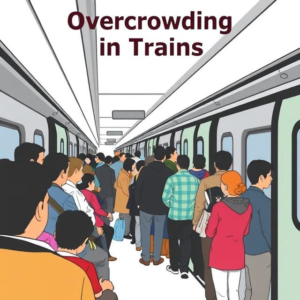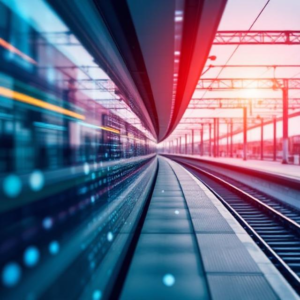1. What is Overcrowding in Trains?
Overcrowding happens when there are too many people on a train, more than the number of seats or standing space available. This can make the train uncomfortable, and sometimes even unsafe. It typically happens during rush hours when more people need to travel, but there aren’t enough trains or space to accommodate everyone.
Examples of Overcrowding:
- People standing in aisles, unable to find a seat.
- Trains that are so full that some passengers can’t even board.
- Difficulty moving around or exiting the train because of the crowd.

2. Why Does Overcrowding Happen?
Overcrowding is caused by a few factors:
- High Demand During Rush Hours: A lot of people need to travel to work or school during the morning and evening hours, but the number of trains or carriages may not be enough to meet the demand.
- Limited Train Frequency: Sometimes, trains come too far apart in terms of time, and people have to squeeze into the ones that are available.
- Insufficient Capacity: If the train system hasn’t been updated for the growing population, there might not be enough trains or space on each train to carry everyone comfortably.
3. What is Crowd Management?
Crowd management refers to the ways in which authorities, like train operators and station staff, control and organize large groups of people to ensure they travel safely and efficiently.
Crowd Management Strategies:
- Train Scheduling: Increasing the frequency of trains during rush hours so there’s less waiting and fewer crowded trains.
- Platform Management: At stations, making sure people are properly lined up to board the train, reducing confusion and chaos. This can include using barriers or markings to guide people.
- Train Coaches with More Capacity: Adding more coaches (carriages) to a train or even longer trains during peak times to reduce overcrowding.
- Controlled Boarding: In some places, there are controlled entry points where people can only board a train in an orderly manner, with station staff helping to manage the flow of people.
- Technology and Communication: Using apps or digital screens to give passengers real-time information about train arrivals, delays, or overcrowding. This can help passengers choose trains that are less crowded.
4. Challenges with Managing Crowds and Overcrowding
Managing crowds in busy train stations and on trains can be tough due to:
- Unexpected Delays: Trains can sometimes be delayed, causing more people to gather at the station, leading to congestion.
- Space Limitations: It’s not always possible to increase the number of trains or carriages if the infrastructure (like tracks or station space) isn’t designed to handle more trains.
- Passenger Behavior: People may try to squeeze in or rush to board, making it harder to manage the crowd.
5. Solutions to Overcrowding
Several solutions can help reduce overcrowding:
- Increasing the Number of Trains: Adding more trains, especially during rush hours, can help reduce overcrowding.
- Expanding Stations: Building larger stations or adding platforms helps accommodate more people.
- Dedicated Coaches for Certain Groups: Some train systems reserve specific coaches for women, elderly people, or those with disabilities, helping reduce overcrowding in certain areas.
- Encouraging Off-Peak Travel: Encouraging people to travel at times other than rush hours can also reduce crowding.
6. Safety Considerations
Overcrowding can make travel unsafe:
- Increased Risk of Accidents: With too many people in a confined space, there’s a risk of accidents, falls, or injuries.
- Difficulty in Evacuating: In case of an emergency, overcrowded trains can make it harder to evacuate passengers quickly.
7. Real-Life Examples of Overcrowding
- Mumbai Local Trains (India): Mumbai’s local trains are famously overcrowded during rush hours, with trains often carrying more passengers than their capacity. Authorities try to address this by adding more trains and introducing dedicated ladies’ coaches.
- London Underground: During rush hours, the London Underground (subway) can also experience overcrowding, especially on certain lines. They manage this by controlling the flow of passengers and improving service frequency.
8. Technological Solutions
- Apps and Digital Tickets: Some cities use mobile apps that let passengers check the real-time number of passengers on a train before they board, helping them avoid overcrowded trains.
- Automated Crowd Control Systems: Some advanced systems use sensors to measure the crowd density at stations or on trains and adjust services accordingly.
Conclusion:
Overcrowding in trains is a common problem, especially during peak travel times, making travel uncomfortable or even unsafe. Crowd management is about controlling the flow of passengers, improving train services, and using technology to make traveling safer and more efficient. By doing this, authorities try to ensure that everyone can travel in a more organized and comfortable way, without feeling cramped or risking safety.
Keywords: Indian Railway, Railway












